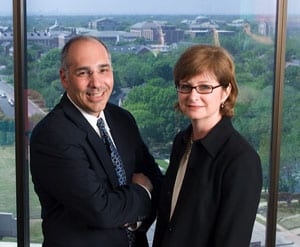 New research by a U.S.-U.K. team that included SMU archaeology student Metin Eren assaults the long-held notion that Neanderthals went extinct because their stone tools were inferior to those made by Homo sapiens.
New research by a U.S.-U.K. team that included SMU archaeology student Metin Eren assaults the long-held notion that Neanderthals went extinct because their stone tools were inferior to those made by Homo sapiens.
Researchers at Southern Methodist University and the University of Exeter report in the “Journal of Human Evolution” that the early stone tool technologies of Neanderthals were as good as, and sometimes even more efficient, than those of Homo sapiens.
The story, “Complexity of Neanderthal tools,” was posted online Aug. 26 by BBC News.
 |
| Metin Eren |
Eren is a graduate experimental archaeology student in the Department of Anthropology of Dedman College of Humanities and Sciences.
The article quotes Eren, lead author on the study, as saying that technologically the research found no clear advantage between the tools of Homo sapiens versus the tools used by Neanderthals.
“When we think of Neanderthals, we need to stop thinking in terms of ‘stupid’ or ‘less advanced’ and more in terms of ‘different,'” Eren is quoted.
Excerpt
“Early stone tools developed by our species Homo sapiens were no more sophisticated than those used by our extinct relatives the Neanderthals.
That is the conclusion of researchers who recreated and compared tools used by these ancient human groups.
The findings cast doubt on suggestions that more advanced stone technologies gave modern humans a competitive edge over the Neanderthals.
The work by a US-British team appears in the Journal of Human Evolution.
The researchers recreated wide stone tools called “flakes,” which were used by both Neanderthals and early modern humans.
They also reconstructed “blades” — a narrower stone tool later adopted by Homo sapiens. Some archaeologists often use the development of stone blades and their assumed efficiency as evidence for the superior intellect of our species.
The team analysed the data to compare the number of tools produced, how much cutting edge was created, the efficiency in consuming raw material and how long tools lasted.
They found no statistical difference in the efficiency of the two stone technologies.”
Related links:
Metin Eren
SMU News: Neanderthals were not ‘stupid’
Journal of Human Evolution: Article
University of Exeter: Press release
Department of Anthropology
Dedman College of Humanities and Sciences
 According to the
According to the  A subsample of about 150 respondents will later be selected for more in-depth interviews, which will take place in 2009.
A subsample of about 150 respondents will later be selected for more in-depth interviews, which will take place in 2009.



